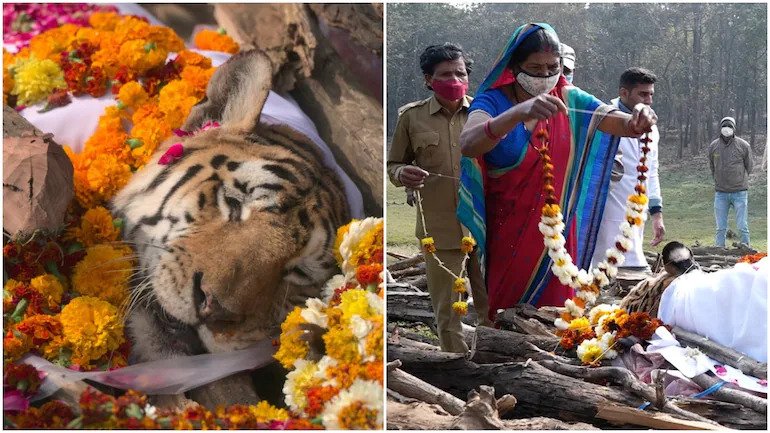
Why should tiger moms have all the fun?

The death of Collarwali, aka ‘Mataram,’ of old age in the Pench National Park in Central India recently sparked off a huge media event, peppered with “heart-felt’’ condolences, photographs and grainy videos pouring in from all over the globe- and justifiably so. Having sired 29 cubs at various stages of her 16-year-old existence, a world record at that, this super mom of a tigress single-handedly propped up Pench to the centre-stage of India’s most popular tiger reserves.
In these reserves, the chances of spotting the elusive big cat remain bright. Ranthambore, Corbett Park, Bandhavgarh and Tadoba-Andhari are some of the other proud members of this hallowed club, their magnetic pull kept alive and kicking not just by the striped residents but also by the big and powerful wildlife tourism lobby, whose primary business may or may not be conservation. But it certainly is to bring the well-heeled DSLR-toting tourists close to the tigers.
Collarwali is not alone in making a tiger reserve proud and popular among the masses. There have been several others like her, each one of them having contributed immensely in bringing fame, constant flow of tourists and much-needed revenue to the reserves and state governments.
Machali’s controversial legacy
Take Machali, for instance. Ranthambore’s prima donna, the Rajasthan Government would have – if granted this wish- made her immortal. Or at least kept her alive for 500 years. But it did the next best thing: it issued a postage stamp in her honour, the first and only instance of unrequited adulation of this kind in India.
Also read: India saw record tiger deaths this year: Data
On the face of it, releasing a postage stamp of a popular tiger looks like a good idea. I recall reaching Ranthambore while shooting a wildlife documentary with Tom Alter few years ago and finding almost the whole of Sawai Madhopur in some kind of collective mourning. It didn’t take us long to figure out the reason for the peoples’ extreme distress. Machali, their most famous draw, had been missing for past 25 days; and horror of horrors, it had started reflecting in the diminishing revenues of not just the forest department but of numerous resorts, hotels and Gypsy owners, catering to streams of visitors who would come to Ranthambore with just one mission: To see and take a few clicks of this “legendary’’ tigress.
According to one news report, Machali’s absence for close to four weeks led to overall revenue loss of ₹200 crore. You don’t believe me? Take a close look at the page one lead story published by Rajasthan’s popular newspaper, which Tom is holding with a bemused look (below).

Fortunately, Machali was discovered three days later in a ravine, by a search team led by Daulat Singh Shekhawat. He was the same forest officer who had lost an eye earlier in a tiger attack, but his love for Ranthambore and its big cats remained undiminished. The news of Machali being re-discovered spread like wildfire, in the process pushing up local television channels’ TRP ratings for a few days. The whole of Sawai Madhopur heaved a collective sigh of relief.
Tigress was kept alive for a purpose
Undoubtedly, Machali was a unique tigress, and most cubs she gave birth to during her productive years have kept the tiger population of Ranthambore super healthy to this day. But a dark cloud hangs over her legacy, the only chink in the larger-than-life aura when the forest department, coffee-table book writers, hoteliers, resort owners and even a few quite well-known film makers attempted to prolong Machali’s life artificially. For close to two years, when Machali lost her power to bag a prey naturally, the forest department of Rajasthan fed her live calf once or so a week.
And all this for what? Just to keep her popularity and relevance alive, for the reasons mentioned above. The postage stamp was the necessary icing on the cake. A few films on Machali hit the international circuits and the last I heard, somebody is writing her “biography’’. Ahem!
Fact remains that in the natural scheme of things in a reserve forest, all tigers are equally important. Many of them become more important, even attain celebrity status (Paarwali of Corbett Park, Charger of Bandhavgarh, Maya of Tadoba Andhari, to name a few) mostly because they are comparatively easier to spot. Over times they stop shying away from tourist vehicles and grant a modern day wildlife photographer his biggest wish: a head-shot!
Who was India’s first celebrity tiger mom?
Speaking of super moms in the world of tigers, who can forget Sita of Bandhavgarh? The venerable National Geographic made the world sit up and take notice when it splashed Sita on the cover of its December 1997 issue, followed by a detailed story with many photographs of this “tiger mother’’ in the inside pages. A few documentaries, at least one by BBC, followed and she even got a prominent mention in the book ‘The Year of the Tiger’. It’s believed the Sita produced six litters, giving birth to 18 cubs, and has been instrumental in stabilizing the tiger population of Bandhavgarh.
Also read: Collarwali, the tigress who gave birth to 29 cubs, no more
But within a year or so of being anointed the media’s darling, Sita disappeared from Bandhavgarh without leaving behind a calling card. Nobody knows for sure what happened- did she die a natural death, as all living things must, or did she fall prey to poachers? But her legacy, crafted lovingly by pre-Google and Facebook media, lives on even today.
Not a bad thing in itself, granting this celebrity status to select tigers. If it helps the forest department in making a reserve popular and profitable, it’s fine and even desirable. But in reality it doesn’t happen like this. The late great Billy Arjan Singh, who did much for the creation of Dudhwa Tiger Reserve in Uttar Pradesh, put it aptly when he wrote that once a tiger steps outside the protected zone of a reserve, it becomes a “forgotten tiger’’.
The same problem is now being faced inside the reserves. In our collective zeal to put some tigers on a pedestal, for whatever reason, we make several others less relevant. Soon, they become forgotten.
(The writer is a senior media professional).
(The Federal seeks to present views and opinions from all sides of the spectrum. The information, ideas or opinions in the articles are of the author and do not reflect the views of The Federal).


